
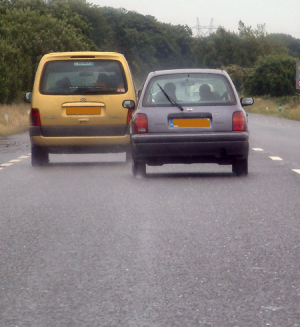 Overtaking might not be the most common cause of road accidents, but overtaking accidents are certainly amongst the most serious.
Overtaking might not be the most common cause of road accidents, but overtaking accidents are certainly amongst the most serious.
You might not get much, or even any chance to overtake on two-way roads during your driving lessons. This makes it even more important to raise your awareness of overtaking risks and how to minimise them.
In an ideal world, overtaking accidents would be prevented by better road design, but many of our roads were built eighty or more years ago, and there is a limit to what can be done to improve them. However, changing the road markings has helped to reduce overtaking accidents.
Road markings include:
Solid white lines along the edge of the carriageway. (These encourage drivers to keep to the centre of their lane rather than positioning to the left.)
Hatching along the centre of two-way roads
Solid centre lines
Hatching to restrict road width on bends
Ultimately, the only way to completely reduce the dangers of overtaking is to change how people drive.
This lesson will give you a head-start towards safe overtaking by helping you to understand the benefits and risks involved and how to do it ‘properly’.
For over 35 3D briefing videos visit Driving test Success. (Google Play | App Store - appstore practical videos available as an in app purchase in the 4 in 1 kit)
You do not have to demonstrate overtaking on your driving test. However, you must take opportunities to 'make progress' - this means to flow with the traffic. To do this, you might have to overtake slow vehicles, for example, street cleaning trucks or cyclists. You may also have to overtake slower vehicles to make progress along dual-carriageways.
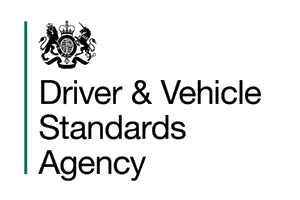
The examiner will want to see:
That any overtake is done in a safe place
Good use of mirrors
Appropriate gear selection in a manual car
Using 'kick-down' appropriately in an automatic
Smooth acceleration control in an electric car (and CVT automatics)
Adequate clearance when passing others
Moving back to the left safely after overtaking
Always ask yourself "do I need to overtake" before starting any overtaking manoeuvre.
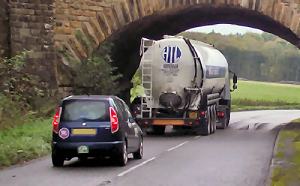
To answer the question you must consider your whole journey and your expected arrival time.
Unless the journey is part of a life-and-death emergency, there is probably never a real 'need' to overtake at all.
Many drivers get frustrated because they only concentrate on the next 100 metres of road space rather than the whole journey."I have to get past this truck!"
But did you know that if you overtake ten cars, you are still only about 20 seconds ahead? You would lose just 20 seconds of your life by choosing not to overtake the cars. A mistake when overtaking could lead to you losing all of it!
Your sat-nav shows your 'estimated time of arrival'. This can help you to recognise that on today's busy roads overtaking will often make little or no difference to your journey time. The only time overtaking can significantly impact the average journey time is when you pass slower traffic at high cruising speeds on motorways.
When following a long traffic queue or approaching a built-up area, overtaking one or two vehicles is unlikely to affect your overall journey time.
If there is a long queue of vehicles ahead, overtaking will certainly not affect your journey time but will increase your risk of a smash. You will move up a place in the queue but won't save time.
If you decide it would be worthwhile to overtake, be patient and wait for the right opportunity.
For example: If there is a dual-carriageway ahead, even if it's a couple of miles away, it will be better to wait until you get there before you overtake.
How much further are you going?
If you are turning off soon, it is probably not worth overtaking.
If you are approaching a town where everyone will have to slow down, an overtake will probably be a waste of fuel and effort.
Even after allowing plenty of time for your journey, there might still be occasions when you want to overtake.
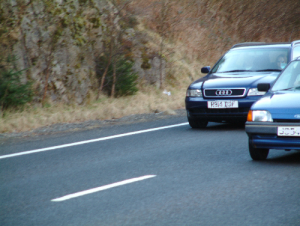
When this situation arises, you must be well equipped with an overtaking plan.
The overtaking plan involves:
Choosing a safe location
Considering other drivers
Controlling your vehicle safely
Each of these elements is explained in detail below.
As you read our advice, keep in mind that if your car is not powerful enough to follow the overtaking method explained in this lesson, or if the vehicle in front is travelling too fast, it is not safe to overtake.
The first considerations here are the Highway Code Rules. You can only overtake on the right except in the following situations:
Passing a vehicle that has signalled to turn right, and you can overtake safely on the left (you must not enter a bus lane during its period of operation).
You are in a one-way street and can pass safely on the left. (You should only do this when following the correct lane for your destination.)
There are two lanes of slow-moving traffic, and the lane to your right is moving more slowly the lane you are in (don't change lanes to overtake in this situation).
Before starting any overtaking manoeuvre, consider the safety of the location and whether it is legal to overtake there.
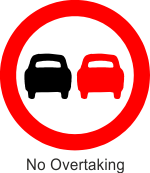
Can you see clearly ahead?
Are there any junctions to the left or right from which vehicles may emerge?
Are there any gateways?
How wide are the footpaths?
You are looking for anything that might make your overtaking manoeuvre unsafe. The obvious things are road features, markings and signs, stuff like bends, hill crests, solid white lines, hatched areas, 'No Overtaking' signs, pedestrian crossings, etc.
The photos below show a clear straight road. What you can't see in the first photo is a car approaching in the 'hidden dip'. Nor can you see whether anything might emerge from an entrance on the right. This is a good example of why it is always important to take notice of road signs and, in this case, the hatched road markings.
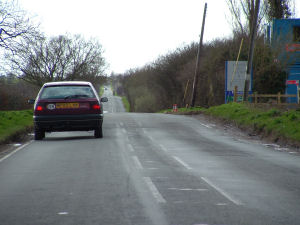
No car visible
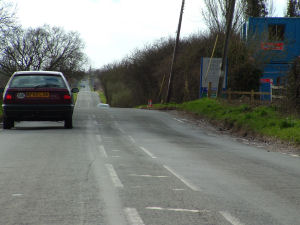
Car roof visible
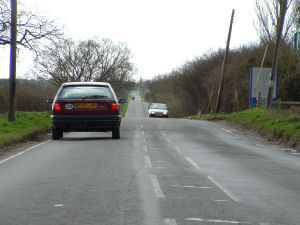
The car appears
Defensive drivers will also be considering other information. For example, a 'cattle' warning sign might draw your attention to a greasy road surface that could cause danger when overtaking; skid marks might indicate a concealed entrance.
You should also aim to find a location that will minimise time spent on the wrong side of the road - with this in mind, you need to actively plan your overtake and be ready to make your move as soon as an opportunity arises.
To reduce the risk of giving approaching drivers a heart attack (from fear!), you must accurately judge the speed of the 'closing gap'.
If two vehicles approach each other at 45 mph and 55 mph respectively, the gap between them will close at approximately 48 metres per second (100 mph!).

In addition to approaching vehicles, you must also consider the vehicle that you intend to pass:
Is it being driven erratically?
Will it start to speed up?
A couple of questions.
The final questions to ask yourself before overtaking are:
Is my manoeuvre Practical?
Consider whether your manoeuvre is practical with regard to time, location safety and need.
Will I upset anyone?
What will other road users think about your decision to overtake? You might think it's perfectly safe to overtake, but if someone else has other ideas (possibly because their judgment is not as good as yours) you could end up on the receiving end of a road rage situation.
It doesn't matter who is right or wrong - the most important thing is getting home alive.
It also makes sense to allow other drivers to overtake you. This doesn't mean you should crawl around at a snail's pace letting everyone pass. It simply means that it is often safer to have someone in front where you can see them, rather than behind, where they might run into you.
There are no 'gold stars' for being stubborn and blocking the path of other drivers. In the worst imaginable situation, you could be involved in someone else's accident or a road-rage incident. Remember that with millions of cars on the road, one extra car in front will make no difference (apart from sometimes making you safer). See Highway Code Rule 168.
To overtake safely, you must be 'quick' and 'stable'.
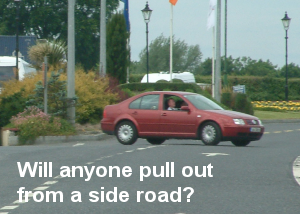
Stable to maintain control, especially if things don't go to plan.
Your ability to be quick will depend to a degree on the vehicle that you are driving. If your car is not powerful enough to overtake using the method described in this lesson, it's not safe to overtake, no matter how good a driver you are.
Avoid the temptation to 'wind up and swoop out' (accelerating hard and darting out into a gap at the last moment).
While the 'wind up and swoop' method might work, you depend on other drivers' actions to maintain your safety margins. If something unforeseen happens, you will be left with no escape route and only your car to protect you from what could be a 100+mph smash!
You can maximise the car's acceleration by choosing an appropriate (lower) gear, using 'kick down' in an automatic. (Electric cars don't need 'kick down' because they don't have gears - just press the power pedal harder.)
Keep your vehicle stable by choosing the safe overtaking path in 'The Method'.

The numbers (shown in brackets) correspond to the numbers shown on the diagram.
Your instructor will run through this method with you and demonstrate the technique.
Ideally, before overtaking on a two-way road, you will start learning to overtake by running through these steps on a dual-carriageway where there is no oncoming traffic.
Note that the red line shows how NOT to overtake (the swoop-out method!).
Mirrors:
Early repeated mirror checks are required to ensure that the road behind is safe and that no one is overtaking you. Be particularly careful if there is a queue of cars behind – drivers could be overtaking from further back in the queue. Make full use of your door mirrors.
Hang-back:
Ensure that you position to maintain maximum forward vision. If the road appears clear ahead of the 'target' vehicle, close the gap to your 'launch point', selecting the most appropriate gear for brisk acceleration. Never hold a position closer to a one-second gap on a good, dry road.
Mirrors/Signals:
Make a final check of all mirrors and give a signal to show that you are moving out. You might also consider a flashing headlamp signal to let the driver in front know that you are there, but be careful; some drivers might interpret this as a sign of aggression. Also, make sure that the vehicle you intend to overtake, or any other vehicle ahead, is not signalling to turn.
Position:
Move out with moderate acceleration (1). Make your final scan of the road, checking that no one will pull out of a gateway or side-turning. Vehicles pulling out from the right will probably not expect you to be on 'their side' of the road and might not see you if they are busy looking to their right for approaching traffic. If the road is still clear, increase power to drive through (2).
Mirrors/Position (2):
Start your gradual, almost straight-line return to the left by ensuring that the 'target' car is clearly visible in the nearside mirror.
Mirrors:
At (3), the overtaken vehicle should be clearly visible in your centre mirror, and you should be pulling away to open the gap (4).

There is a simple rule that sounds strange the first time you hear it. 'Good driving starts in bed' (with the 'ten-minute rule').
The 'ten-minute rule' means that you will be safer if you get out of bed ten minutes earlier and allow more time for your journey.
Of course, you might not start in bed, and you can use the ten-minute rule anytime!
Allowing an extra ten minutes of journey time for every hour you expect to travel will remove a lot of stress from your driving because there will never be a need to rush or overtake.
Many people crash and suffer life-changing injuries or worse because they are late for work, an appointment, or even rushing home to watch a TV programme!
The ten-minute rule will significantly reduce the chance that you will run late. But, if you think that is a chance you might be late, phone ahead to let people at the other end know - this will remove the stress from your journey (and they can record the TV programme for you!)
Although it sounds clichéd, it's better to arrive late than never arrive at all.
 Overtaking Quiz...
Overtaking Quiz...Click here to complete the quiz for this lesson
(The page will open in a new window/tab)
You will find references for the answers in this lesson.
You can check your answers as you go along, or complete the full quiz before checking.
Leaving the check to the end is a good way to test yourself.
When you check or review your answers you will get a brief explanation of the answer.
Good Luck!